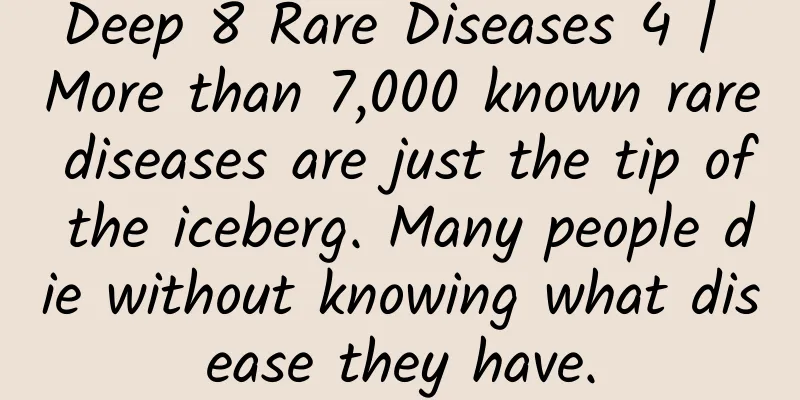Deep 8 Rare Diseases 4 | More than 7,000 known rare diseases are just the tip of the iceberg. Many people die without knowing what disease they have.

|
Mr. Lin from Xinjiang is a laboratory doctor. He has two daughters, the older one is over 4 years old and the younger one is over 1 year old. The older daughter started to learn to walk at 1 year and 7 months old, but her walking was always unstable. She still staggers until now, and her legs feel like they are stepping on light cotton. She went to the hospital for examination, and the motor nerves were basically normal. The cranial MRI, nerve B-ultrasound, and metabolite tests were all normal. Mr. Lin and his wife took their eldest daughter to many famous neurology clinics and made more than 20 appointments with specialists. The clinical diagnosis was "hereditary sensory neuropathy", but after two genetic tests, no clear pathogenic gene was found. Because of the abnormality of the eldest daughter, Mr. Lin paid more attention to the youngest daughter after she was born. When the youngest daughter started to learn to walk at the age of one, Mr. Lin specially checked her knee jerk reflex and found that she had none. Would the youngest daughter also suffer from the same "strange disease" as her sister? So, the youngest daughter was also tested for genes, but no clear disease-causing gene was found. He went to many places including Chongqing, Chengdu and Beijing for medical treatment but the diagnosis could not be confirmed. Mr. Lin judged that his daughter's disease should be some kind of rare genetic disease. As a medical worker, Mr. Lin carefully analyzed the genetic test reports of his two daughters and found that both of our girls have the same compound heterozygous mutation of the COX20 gene, which was inherited by me and my wife. Following this clue, Mr. Lin searched for relevant keywords on the biomedical literature database PubMed. His efforts paid off and he found an English paper published by Professor Wu Zhiying's team a few months ago. "I think the cause of the disease has probably been found. The symptoms of our eldest daughter are very consistent with the article published by your team." Mr. Lin wanted to know how his daughter's disease was diagnosed, what the final prognosis was, and what treatment measures could be taken. He sent an email to Professor Wu Zhiying. The paper that Mr. Lin searched for was published in Brain, an authoritative journal in the field of neuroscience, in March 2021. It is the result of six years of research by Professor Wu Zhiying's team. There are many patients with hereditary sensory neuropathy in the rare disease clinic of Zhejiang University Second Hospital. Wu Zhiying's team keenly discovered that among the patients who came for treatment, 8 patients had compound heterozygous mutations in the COX20 gene. From this, they speculated that this mutated gene might be the common cause of their illness. Therefore, the team members began to track and follow up these eight patients, and explored in depth the pathogenic mechanism of COX20 mutation. The final chain of evidence showed that COX20 mutation does reduce the function of nerve cells, thereby destroying sensory function. After contacting Wu Zhiying's team, Mr. Lin asked experts in Beijing to analyze the cause of the disease again based on the genetic test results. Finally, experts from Peking University Hospital also agreed that the disease was a hereditary sensory neuropathy caused by COX20 gene mutation. At this point, the mystery that had been lingering in his mind was finally solved. After determining the cause of the disease, Mr. Lin was most concerned about the prognosis of his daughter's disease and whether there was any treatment. Doctor Yu Hao from Professor Wu Zhiying's team told him that among the eight patients at Zhejiang University Second Hospital, one was already in his 40s. Although he had unsteady walking, muscle atrophy and some problems with his foot joints, it did not affect his life and he could still work and live normally. Although there is no specific drug for hereditary sensory neuropathy caused by COX20 gene mutation, Dr. Yu Hao's response greatly alleviated the anxiety of Mr. Lin and his family. Mr. Lin said that if there are new treatments and clinical trials in the future, his family is willing to participate in the team's research. The family of rare diseases is constantly evolving. At present, there are more than 7,000 rare diseases recognized in the world, but new rare diseases are still being discovered every year. It is conservatively estimated that there are more than 20 million patients in my country, most of whom are "undiagnosed diseases." Undiagnosed diseases may include unnamed groups of diseases with common characteristics, diseases with well-described phenotypes, diseases with unknown molecular basis, or diseases caused by unknown non-genetic factors. Most of them are not yet fully recognized medically and are a global health problem that requires international scientific and healthcare efforts. From this perspective, patients who can be diagnosed with a rare disease are already "lucky" because some people may never know what disease they have even if they are sick. Diagnosis of rare diseases is not the most difficult The real challenge is treatment Professor Wu Zhiying said that in clinical practice, many people have similar experiences as Mr. Lin's family. They have gone to many places for medical treatment, but the cause of the disease has never been determined. One of the goals of the International Rare Disease Research Consortium (IRDiRC) for 2017-2027 is that all suspected rare disease cases with a medical precedent will be diagnosed within one year of the initial diagnosis; all currently undiagnosed cases will enter the diagnosis and research process under global collaboration. Undiagnosed diseases are the "ultimate challenge for human understanding of disease" in the medical field. However, in Wu Zhiying's opinion, the diagnosis of rare diseases is not the most difficult; the real difficulty lies in treatment. Among the more than 7,000 known rare diseases, less than 5% have effective treatments. Among the 121 diseases included in China's first batch of rare disease catalogs, only about 60% are "treatable with medicines." There is currently a gap in the treatment of most rare diseases. "Although the reality is cruel, I hope patients will not lose confidence," said Professor Wu Zhiying. "Some rare diseases do not have treatment drugs yet. I hope patients understand that being alive is the most important thing. Being alive means there is hope. Maybe in three to five years, drugs will be developed." Orange Persimmon Interactive reporter Yu Qianqian Zhang Jing Correspondent Fang Xulu Qingtong Xiaoxian |
>>: How many years can you wear a pair of glasses?
Recommend
The whole process of a woman giving birth
In recent years, in order to make men understand ...
What to do if you have hemorrhoid bleeding during late pregnancy
When pregnant women reach the late stage of pregn...
Why is the egg tart crust too soft? How do you know if the egg tart is cooked?
Recently, we have shared some common knowledge ab...
What causes nosebleeds during menstruation?
Healthy maintenance is particularly important for...
What should I do if I keep having intercourse during pregnancy?
During pregnancy, due to the greater changes in h...
Frequent causes of milk lumps
In addition to the problems of cesarean section d...
What causes thigh pain in pregnant women?
After pregnant women become pregnant, female frie...
The harm of taking amino acids to pregnant women
Many pregnant women are still worried about the b...
Precautions after drug curettage
Medical curettage is a surgery that is actually v...
Why do snail noodles need to be cooked twice? What is the secret to delicious snail noodles?
The soup of snail noodles is made of snails, gala...
Graduation season - pay more attention to college students' mental health
According to data released by the Ministry of Edu...
Brown vaginal discharge with blood and stomach pain
If a woman's leucorrhea contains blood, it ma...
How to treat subcutaneous breast nodules?
Dear female friends, you must pay attention to yo...
4 types of women who may turn into beasts in bed
American sexologist Edward Morley wrote that men ...
Why does a pregnant woman’s eyelids twitch?
Children are important treasures in the eyes of t...









